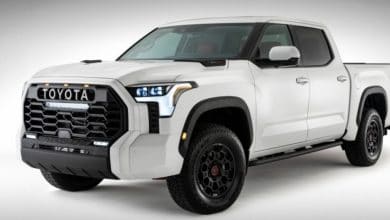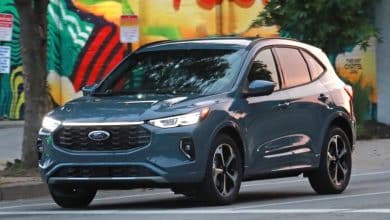
(Halfmoon Bay, British Columbia) Hyundai's portfolio currently includes five utility vehicles. Of this number, there is one too many: the Santa Fe. Born 25 years ago, this utility vehicle has gradually lost its bearings and its customers due to an image that is too diffuse. The fifth generation with its squared line wishes to correct the situation, but the arguments put forward sometimes lack conviction.
The Santa Fe, Hyundai's oldest utility vehicle, runs the risk of originality. Long uneven and often slightly boring, the Santa Fe is trying to find its way again. And, as in all latest creations, the Hyundai style is less identifiable than that of other manufacturers who feel the need to reproduce their products – regardless of size – in order to preserve the “image of the brand”. Hyundai is taking a different path, even if this fifth generation of Santa Fe looks like a South Korean Land Rover… Especially in profile. It doesn't take much for us to imagine this utility vehicle wallowing in the mud rather than posing in front of the local daycare. Always dream! Despite the presence of an XRT version, the Santa Fe does not have the soul of a real adventurer.
Deposited on the N3 architecture (used by the Sonata since 2019), the Santa Fe will first be offered with a turbocharged gasoline engine. This will be produced in the United States. Then, during the summer, a hybrid version (non-rechargeable) will enter the market from the South Korean facilities of the stylized H brand. Against all expectations, the latter will be sold at a better price (starting at $40,399) and should logically represent the majority of sales. In Quebec, at least.
Weight gain
-

PHOTO PROVIDED BY HYUNDAI
The new Santa Fe is longer and taller. These gains made it possible to release more volume inside.
-

PHOTO PROVIDED BY HYUNDAI
The interior of the Hyundai Santa Fe
-

PHOTO PROVIDED BY HYUNDAI
The steering of the Hyundai Santa Fe demonstrates lightness and precision for a vehicle intended for family use.
-

PHOTO PROVIDED BY HYUNDAI
The middle row of seats in the Hyundai Santa Fe
-

PHOTO PROVIDED BY HYUNDAI
The Hyundai Santa Fe selector
-

PHOTO PROVIDED BY HYUNDAI
The third row of seats in the Hyundai Santa Fe
-

PHOTO PROVIDED BY HYUNDAI
The trunk of the Hyundai Santa Fe
-

PHOTO PROVIDED BY HYUNDAI
The cargo volume of the Hyundai Santa Fe
-

PHOTO PROVIDED BY HYUNDAI
The engine of the Hyundai Santa Fe
1/9
Compared to the cheesy generation that preceded it, the new Santa Fe is longer and taller. These gains have made it possible to free up more volume inside, which mainly benefits the occupants of the middle section. The second ? Indeed, since the Santa Fe is now offered as standard with three rows of seats. The third, as is often the case, is reserved for small people. On the other hand, the utility volume is not. The wide cutout in the tailgate allows you to effortlessly line up three bikes (rear seat folded). Do you prefer to climb them on the roof? Hyundai invites you to easily access it by holding on to a retractable (and lockable) metal plate housed in the “C” pillar while one of your feet is balanced on one of the rear wheels.
The interior design of the Santa Fe makes a clean sweep of the past. This is more obvious in the Calligraphy version (our photos) which adopts brighter colors and new features that are sure to make you smile. For example, this box which ensures that small objects are sterilized. Or again, these front buckets whose extent of adjustment encourages you to lie down for a nap. Other ideas? Yes, like the induction charging tray attached to the front console which can accommodate two mobile phones. That said, the steering wheel will probably seem very small for a vehicle of this size. This is not a problem, unlike the selector connected to the steering column (Hyundai's new fad). The latter is not the most convenient.
A problematic box
On the peaceful roads of Halfmoon Bay Island, the Santa Fe neither excites nor disappoints anyone behind its controls. The steering demonstrates lightness and precision for a vehicle intended for family use. We prefer the Calligraphy version to the XRT, quieter and more precise to drive.
The XRT's more off-road tires and its increased ground clearance not only have an impact on handling, but also on consumption. This, however, is not exceptional, far from it. This 2.5L four-cylinder, a little rough when accelerating, is here associated with a dual-clutch automatic transmission. We still wonder why due to its complexity and maintenance cost. It was undoubtedly chosen for its speed of execution in order to keep the engine in its optimal operating range. The hybrid version, less powerful and much more economical (see our tables), will use a traditional six-speed gearbox. This mechanical assembly was not present during this media preview.
The main advantage of the XRT and Calligraphy versions lies essentially in their towing capacity. The XRT especially, which has twice the towing capacity of the hybrid. If this is not a criterion, move on. The planet will breathe better.
Hyundai Santa Fe
Price range
From $40,499 to $53,499
Trial versions
- Calligraphy and XRT
- CO2 (g/km): 249 (Calligraphy), 254 (XRT)
Consumption and autonomy
10.6 L/100 km (Santa Fe gasoline except XRT); 10.8L/100km (XRT); 6.9 L/100 km (hybrid)
WE love
- Distinct Appearance
- Airy and bright interior
- Safe and surprise-free behavior
We like less
- Fuel consumption
- Double clutch gearbox
- Unwelcoming third row
Our Verdict
Better to wait for the hybrid version
Share your experience
The Press will soon publish the test of the following vehicles: Cadillac Lyriq, Chevrolet Blazer EV, Ford Ranger, Subaru Forester and Toyota Camry. If you own one of these vehicles or are awaiting delivery, we would love to hear from you.
Write to us to tell us about your experience












